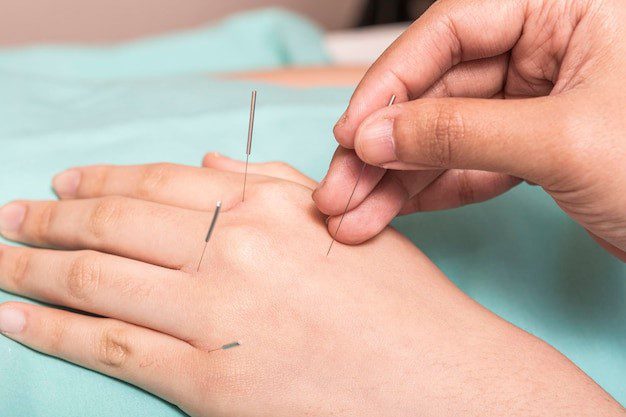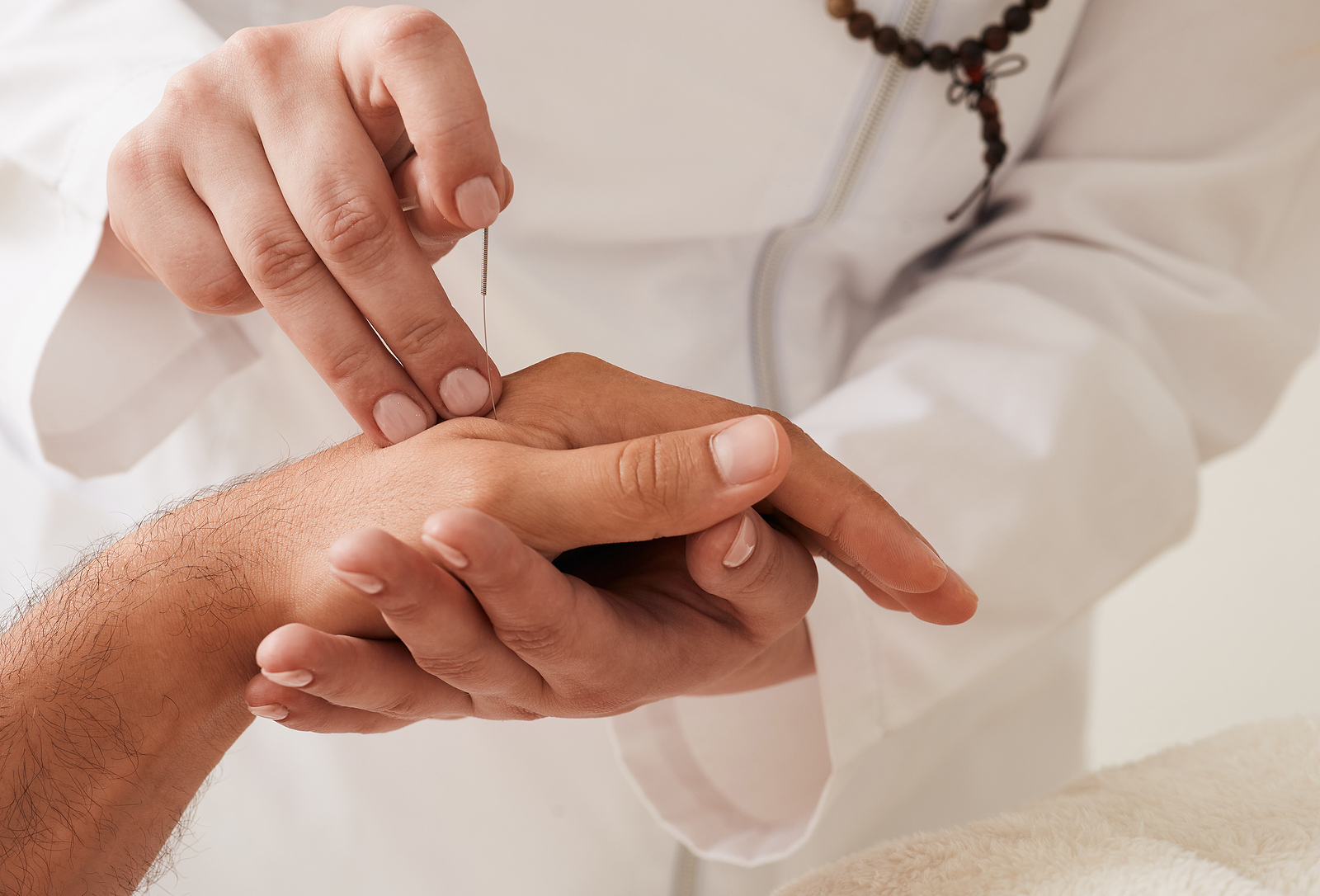Numbness in Hands and Acupuncture Treatment in Tokyo
Numbness in the hands, a common yet distressing symptom, can significantly impact daily activities, from typing to holding objects. This sensation, often described as tingling, “pins and needles,” or a loss of feeling, may stem from various causes, ranging from nerve compression to systemic conditions. While conventional treatments like medication or surgery are effective for some, many individuals turn to complementary therapies such as acupuncture to manage symptoms and restore function. Rooted in Traditional Oriental Medicine (TOM), acupuncture involves stimulating specific points on the body to promote healing and alleviate discomfort. This article explores the nature of numbness in the hands, the effectiveness of acupuncture as a treatment, and the key acupoints used to address this condition. By combining scientific insights, TOM principles, and practical guidance, we aim to provide a thorough resource for those seeking natural relief from hand numbness.
- Understanding Numbness in Hands
- What is Numbness in Hands?
- Symptoms and Associated Discomfort
- The Pain and Discomfort of Hand Numbness
- Acupuncture Treatment in Tokyo
- What is Acupuncture?
- Acupuncture in the Context of Hand Numbness
- Effectiveness of Acupuncture for Numbness in Hands
- Scientific Evidence
- Limitations of Current Research
- Patient Experiences
- Key Acupoints for Numbness in Hands
- Integrating Acupuncture with Conventional Treatment
- Practical Tips for Seeking Acupuncture
- Potential Benefits Beyond Numbness Relief
- Challenges and Considerations
- Conclusion
Understanding Numbness in Hands
What is Numbness in Hands?
Numbness in the hands refers to a loss of sensation or abnormal sensations, such as tingling, prickling, or a “falling asleep” feeling. It may affect one or both hands, specific fingers, or the entire hand, and can range from mild and temporary to severe and chronic. Numbness often results from disruptions in nerve function, which may involve peripheral nerves, the spinal cord, or the brain.
Maybe You Need:
Common causes of hand numbness include:
- Carpal Tunnel Syndrome (CTS): Compression of the median nerve in the wrist, often due to repetitive motions or prolonged wrist flexion, is a leading cause. CTS typically causes numbness in the thumb, index, and middle fingers.
- Cervical Radiculopathy: A pinched nerve in the neck (cervical spine) can cause numbness, tingling, or pain radiating to the hands.
- Peripheral Neuropathy: Damage to peripheral nerves, often due to diabetes, vitamin B12 deficiency, or alcohol use, can lead to numbness in the hands and feet.
- Thoracic Outlet Syndrome (TOS): Compression of nerves or blood vessels in the upper chest can cause numbness in the hands, particularly the ring and pinky fingers.
- Ulnar or Radial Nerve Compression: Pressure on the ulnar nerve (e.g., at the elbow, causing “funny bone” sensations) or radial nerve can lead to numbness in specific areas of the hand.
- Systemic Conditions: Hypothyroidism, multiple sclerosis, or autoimmune disorders like rheumatoid arthritis may cause numbness as a secondary symptom.
- Injury or Trauma: Fractures, sprains, or repetitive strain injuries can damage nerves, leading to numbness.
- Poor Circulation: Conditions like Raynaud’s disease or vascular issues can reduce blood flow, causing numbness or tingling.

Symptoms and Associated Discomfort
Numbness in the hands is often accompanied by other symptoms, depending on the underlying cause:
- Tingling or “Pins and Needles”: A prickling sensation, often described as the hand “waking up” after being asleep.
- Burning or Pain: Some individuals experience a burning sensation or sharp pain alongside numbness, especially in nerve compression syndromes.
- Weakness: Reduced grip strength or difficulty holding objects may occur, particularly in CTS or peripheral neuropathy.
- Coldness or Swelling: Poor circulation or fluid retention can cause the hands to feel cold or appear swollen.
- Loss of Dexterity: Fine motor tasks, like buttoning a shirt or writing, may become challenging.
- Radiating Symptoms: Numbness may extend to the forearms, shoulders, or neck in cases of cervical radiculopathy or TOS.
The Pain and Discomfort of Hand Numbness
While numbness itself is not always painful, it is often accompanied by discomfort that affects quality of life. The associated pain or sensations may include:
- Nerve Pain (Neuropathic Pain): Sharp, shooting, or burning pain may occur, particularly in CTS or peripheral neuropathy. This pain can be intermittent or constant and may worsen at night.
- Muscle Aches or Cramps: Prolonged numbness can lead to muscle stiffness or cramping due to reduced movement or nerve signaling.
- Sensory Disruption: The inability to feel textures, temperatures, or pressure can lead to frustration or accidental injuries (e.g., burns from hot objects).
- Functional Limitations: Numbness can impair tasks requiring precision, such as typing, cooking, or playing instruments, leading to emotional distress or reduced productivity.
- Sleep Disturbances: Nighttime symptoms, common in CTS, can disrupt sleep, contributing to fatigue and irritability.
These discomforts can range from mild annoyances to debilitating symptoms, prompting many to seek relief through therapies like acupuncture, which targets both the physical and emotional aspects of numbness.
Acupuncture Treatment in Tokyo
What is Acupuncture?
Acupuncture is a cornerstone of TOM, practiced for over 2,500 years. It involves inserting fine, sterile needles into specific points on the body, known as acupoints, to restore balance and promote healing. In TOM, health is maintained by the smooth flow of vital energy through meridians, or energy pathways. Blockages or imbalances in Energy can lead to symptoms like numbness, pain, or weakness. Acupuncture aims to restore Energy flow, improve circulation, and support the body’s natural healing processes.
From a Western medical perspective, acupuncture may work by:
- Mod Skipting the Nervous System: Needle insertion stimulates nerve endings, triggering the release of endorphins and other neurotransmitters that reduce pain and promote relaxation.
- Reducing Inflammation: Acupuncture may lower levels of pro-inflammatory cytokines, helping to alleviate nerve irritation and swelling.
- Improving Blood Flow: Enhanced circulation to affected areas can reduce numbness and support nerve repair.
- Regulating Nerve Signals: Acupuncture may modulate nerve signaling, potentially relieving symptoms of nerve compression or neuropathy.

Acupuncture in the Context of Hand Numbness
In TOM, numbness in the hands is often attributed to Energy stagnation, blood stasis, or deficiencies in Yin or Yang, particularly affecting the meridians that run through the arms and hands (e.g., Lung, Heart, and Large Intestine meridians). Acupuncture for hand numbness aims to:
- Clear blockages in meridians to restore sensation.
- Improve blood and Energy flow to reduce tingling and pain.
- Strengthen the body’s energy to address underlying deficiencies.
- Relieve associated symptoms like pain, weakness, or stiffness.
Acupuncture is typically used as a complementary therapy, often alongside physical therapy, medication, or lifestyle changes, to address both symptoms and their root causes.
Effectiveness of Acupuncture for Numbness in Hands
Scientific Evidence
Research on acupuncture for hand numbness, particularly in conditions like carpal tunnel syndrome and peripheral neuropathy, suggests it can be an effective complementary treatment. Below is a summary of key findings:
- Carpal Tunnel Syndrome (CTS): A 2017 study published in The Journal of Pain found that acupuncture was as effective as corticosteroid injections for reducing symptoms of CTS, including numbness, tingling, and pain. Participants receiving acupuncture reported significant improvements in sensation and grip strength after 4–8 weeks of treatment. Another 2019 meta-analysis in Frontiers in Neuroscience confirmed that acupuncture reduced symptom severity in CTS, with benefits comparable to wrist splinting.
- Peripheral Neuropathy: A 2020 systematic review in Evidence-Based Complementary and Alternative Medicine evaluated acupuncture for diabetic peripheral neuropathy, a common cause of hand numbness. The review found that acupuncture improved nerve conduction velocities and reduced numbness and tingling, particularly when combined with vitamin B12 supplementation. Patients also reported reduced pain and improved quality of life.
- Cervical Radiculopathy: A 2018 study in Acupuncture in Medicine explored acupuncture for nerve-related symptoms due to cervical spine issues. Participants experienced reduced numbness and pain in the hands and arms after 6–12 sessions, likely due to improved nerve signaling and reduced inflammation.
- General Pain and Numbness Relief: Acupuncture’s analgesic effects are well-documented. A 2021 study in Pain Medicine suggested that acupuncture modulates pain pathways by increasing endorphin levels and reducing nerve hypersensitivity, which can alleviate neuropathic symptoms like numbness and tingling.
- Improved Circulation: A 2019 study in Journal of Alternative and Complementary Medicine found that acupuncture improved microcirculation in the hands, potentially reducing numbness caused by poor blood flow, such as in Raynaud’s disease or TOS.
Limitations of Current Research
While these findings are promising, limitations exist:
- Heterogeneity in Studies: Variations in acupuncture protocols, session frequency, and patient populations make it challenging to standardize results.
- Placebo Effect: Some studies report similar outcomes with sham acupuncture (needling non-acupoints), suggesting a placebo component in symptom relief.
- Short-Term Benefits: Most studies focus on short-term outcomes, with less data on long-term efficacy.
- Complementary Role: Acupuncture is not a standalone cure for underlying causes like diabetes or severe nerve compression, and it works best alongside conventional treatments.
Despite these limitations, acupuncture is widely regarded as a safe and effective option for symptom management, particularly for those seeking non-pharmacological approaches.

Patient Experiences
Anecdotal reports from patients highlight acupuncture’s benefits for hand numbness:
- Reduced Numbness and Tingling: Many patients report decreased “pins and needles” sensations after 4–10 sessions, particularly in CTS or neuropathy.
- Improved Hand Function: Patients often regain dexterity for tasks like typing or gripping, enhancing daily productivity.
- Pain Relief: Acupuncture frequently reduces associated neuropathic pain, improving comfort during the day and night.
- Enhanced Well-Being: Patients note reduced stress and better sleep, which may indirectly alleviate numbness-related discomfort.
These subjective improvements underscore acupuncture’s role in improving quality of life, even if it does not address the underlying cause directly.
Key Acupoints for Numbness in Hands
In TOM, acupoints are selected based on the patient’s symptoms, the affected meridians, and the underlying imbalance (e.g., Energy stagnation or blood stasis). Below are key acupoints commonly used for hand numbness, their locations, and their therapeutic roles. Acupoint selection should always be guided by a licensed acupuncturist after a thorough assessment.
- Large Intestine 4 (Hegu)
- Location: In the webbing between the thumb and index finger, at the highest point of the muscle when the thumb and finger are pressed together.
- Purpose: A “master point” for the upper body, Hegu promotes Energy and blood flow, reduces pain, and alleviates numbness in the hands. It is particularly effective for CTS and general neuropathic symptoms.
- Application: Often needled bilaterally to enhance systemic effects. Caution is advised in pregnant patients, as this point can stimulate contractions.

- Pericardium 6 (Neiguan)
- Location: On the inner forearm, about 2 inches above the wrist crease, between the tendons.
- Purpose: Regulates Energy in the chest and arms, relieves numbness, and calms the nervous system. It is commonly used for CTS and TOS-related numbness.
- Application: Gentle needling or acupressure is effective, often combined with other points for synergistic effects.
- Large Intestine 10 (Shousanli)
- Location: On the outer forearm, about 2 inches below the elbow crease, along the line connecting the elbow to the wrist.
- Purpose: Promotes circulation in the arm and hand, reducing numbness, pain, and weakness. It is particularly useful for radial nerve issues or generalized arm numbness.
- Application: Deep needling may be used to stimulate nerve pathways.
- Triple Energizer 5 (Waiguan)
- Location: On the outer forearm, about 2 inches above the wrist crease, opposite Pericardium 6.
- Purpose: Clears blockages in the Triple Energizer meridian, which governs fluid metabolism and circulation in the arms. It is effective for numbness, tingling, and swelling in the hands.
- Application: Often paired with Pericardium 6 to balance inner and outer arm meridians.

- Baxie (Extra Points)
- Location: Eight points located in the webbing between the fingers (four on each hand).
- Purpose: These extra points directly target hand numbness, pain, and stiffness, particularly in CTS or arthritis-related symptoms. They promote local circulation and nerve function.
- Application: Light needling or acupressure is used due to the sensitivity of the area.
- Lung 9 (Taiyuan)
- Location: On the wrist crease, in the depression on the radial side of the radial artery.
- Purpose: Strengthens the Lung meridian, which governs Energy in the upper body, and improves circulation to the hands. It is used for numbness caused by poor circulation or respiratory-related conditions.
- Application: Gentle needling to avoid the radial artery.
- Cervical Points (e.g., Gallbladder 20, Fengchi)
- Location: At the base of the skull, in the hollows between the neck muscles.
- Purpose: Used for numbness caused by cervical radiculopathy or TOS, these points relieve nerve compression and improve blood flow to the arms and hands.
- Application: Needled cautiously due to the proximity of vital structures.
Treatment Protocols
A typical acupuncture session for hand numbness involves:
- Assessment: The acupuncturist evaluates the patient’s symptoms, pulse, tongue, and medical history to identify the root cause (e.g., nerve compression, Energy stagnation, or blood stasis).
- Point Selection: 6–12 acupoints are chosen, combining local points (e.g., Baxie, Hegu) with distal points (e.g., Pericardium 6, Triple Energizer 5) to address both symptoms and underlying imbalances.
- Session Frequency: Weekly or biweekly sessions for 6–12 weeks are common, with maintenance sessions every 4–6 weeks for chronic conditions.
- Adjunctive Therapies: Electroacupuncture (mild electrical stimulation through needles), moxibustion (warming with mugwort), or cupping may enhance effects, particularly for circulation-related numbness.
- Duration: Sessions last 30–60 minutes, with needles retained for 15–30 minutes.
Safety Considerations
Acupuncture is generally safe when performed by a licensed practitioner, but patients with hand numbness should:
- Inform their acupuncturist about underlying conditions (e.g., diabetes, CTS) and medications, as these may influence treatment response.
- Avoid acupuncture if they have bleeding disorders or are on blood thinners, as needling may cause bruising.
- Ensure sterile needles are used to prevent infection.
- Seek medical evaluation for persistent or worsening numbness, as acupuncture is not a substitute for diagnosing or treating underlying conditions like diabetes or cervical disc issues.
Integrating Acupuncture with Conventional Treatment
For optimal management of hand numbness, acupuncture should complement conventional treatments, such as:
- Medical Evaluation: Diagnosing the root cause (e.g., CTS, neuropathy, or cervical issues) through imaging, nerve conduction studies, or blood tests is critical.
- Medications: Anti-inflammatory drugs, pain relievers, or vitamin supplements (e.g., B12 for neuropathy) may be prescribed alongside acupuncture.
- Physical Therapy: Exercises to improve wrist mobility, strengthen muscles, or correct posture can enhance acupuncture’s effects.
- Lifestyle Changes: Ergonomic adjustments (e.g., proper keyboard positioning), weight management, and blood sugar control are essential for conditions like CTS or diabetic neuropathy.
- Surgical Options: In severe cases (e.g., advanced CTS or cervical disc herniation), surgery may be necessary, with acupuncture supporting recovery.
Patients should maintain open communication with their healthcare providers to ensure a coordinated approach.

Practical Tips for Seeking Acupuncture
If you’re considering acupuncture for hand numbness, follow these steps:
- Find a Licensed Acupuncturist: Seek practitioners certified by organizationsเช่น the National Certification Commission for Acupuncture and Oriental Medicine (NCCAOM).
- Discuss Your Symptoms: Share details about your numbness, including onset, severity, and associated symptoms, during the initial Magnetostimulation.
- Set Realistic Expectations: Understand that relief may require multiple sessions (typically 6–12) and that results vary based on the cause of numbness.
- Track Progress: Keep a symptom journal to monitor changes in numbness, pain, or hand function to evaluate acupuncture’s effectiveness.
- Budget for Treatment: Sessions typically cost $50–$150, and insurance coverage varies. Check with your provider for details.
Potential Benefits Beyond Numbness Relief
Acupuncture’s holistic approach may offer additional benefits for individuals with hand numbness:
- Stress Reduction: By calming the nervous system, acupuncture can lower stress levels, which may exacerbate nerve-related symptoms.
- Improved Sleep: Better sleep quality can reduce fatigue, which may worsen the perception of numbness or pain.
- Enhanced Circulation: Improved blood flow can support nerve health and reduce symptoms like coldness or swelling in the hands.
- Pain Management: Acupuncture’s analgesic effects can address associated neuropathic pain or muscle tension.
Challenges and Considerations
While acupuncture is promising, challenges include:
- Time Commitment: Regular sessions require consistency, which may be difficult for those with busy schedules.
- Variable Response: Not all patients experience significant relief, particularly if the underlying cause (e.g., severe nerve damage) is not addressed.
- Cost: Without insurance, long-term treatment can be expensive.
- Access: Qualified acupuncturists may be less available in rural areas.
Conclusion
Numbness in the hands, whether caused by carpal tunnel syndrome, peripheral neuropathy, or other conditions, can be a frustrating and limiting symptom. Acupuncture offers a safe, natural approach to managing numbness, tingling, and associated discomfort by promoting Energy flow, reducing inflammation, and improving circulation. Key acupoints like Hegu, Neiguan, and Baxie are commonly used to target hand numbness, with protocols tailored to each patient’s unique needs. Scientific evidence supports acupuncture’s effectiveness for conditions like CTS and neuropathy, particularly when combined with conventional treatments like physical therapy or medication.
For those considering acupuncture, working with a licensed practitioner and coordinating with healthcare providers ensures a comprehensive approach. By addressing both symptoms and underlying imbalances, acupuncture can enhance hand function, reduce discomfort, and improve overall well-being. If you’re struggling with hand numbness, consult a qualified acupuncturist to explore how this time-tested therapy can support your journey to relief.
If hand numbness is affecting your daily life, consider acupuncture as a complementary therapy. Contact a licensed acupuncturist to discuss your symptoms and develop a personalized treatment plan. Always consult your healthcare provider to ensure acupuncture aligns with your medical needs. Take the first step toward natural relief today and regain control of your hand function and comfort.
Fuji Wellness:
- Address: 132-0031 Matsushima 1-chome, 21-14, Tokyo, Japan
- Chat with us: Click here
- Email: sunnyphamsensei@gmail.com



